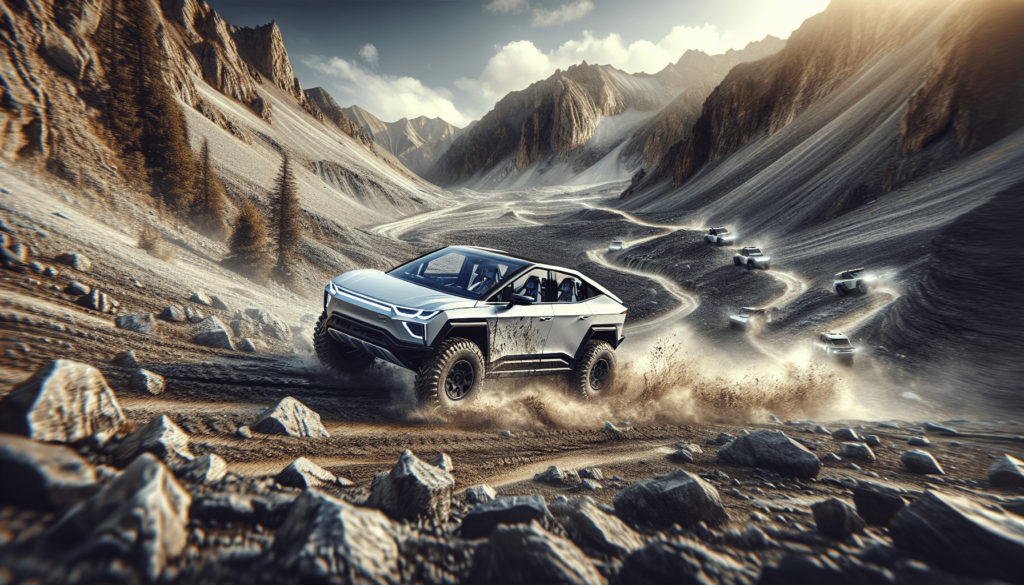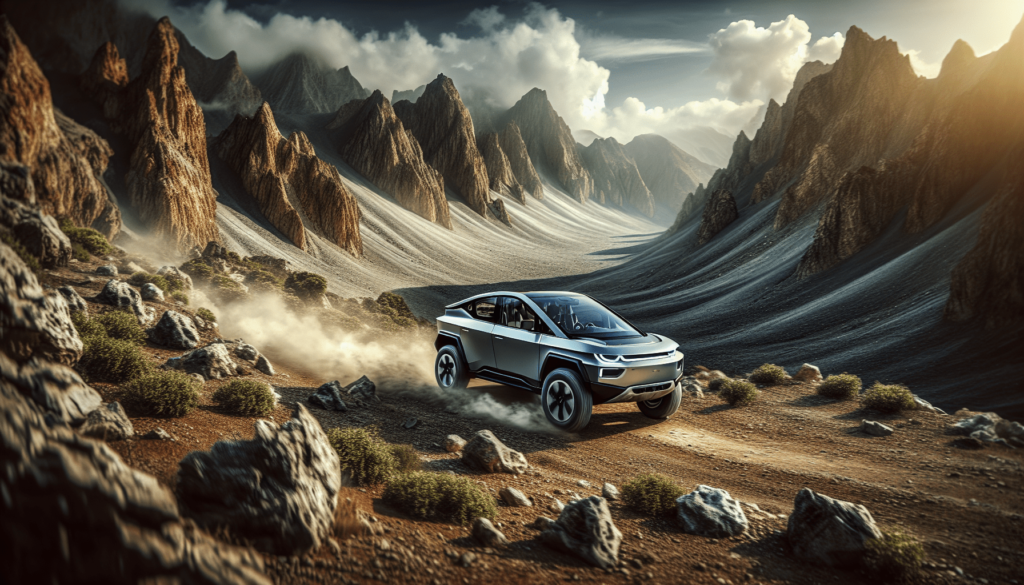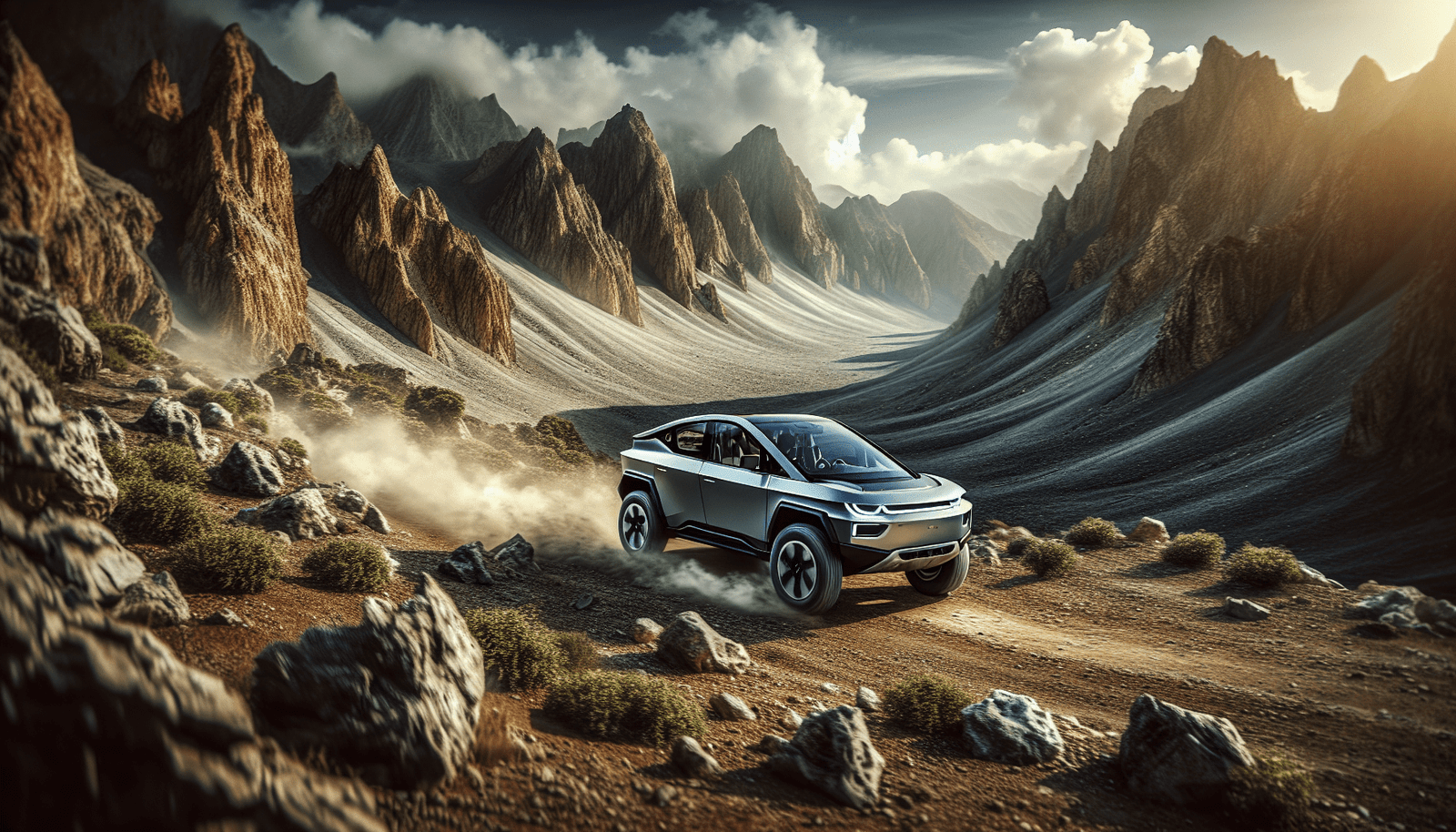Imagine embarking on an outdoor adventure with your trusty electric vehicle, ready to conquer off-road trails and rugged terrains. But how exactly do these vehicles hold up in such demanding conditions? Are they as capable and reliable as their gasoline-powered counterparts? In this article, we will explore the performance of electric vehicles off the beaten path, discovering the challenges they face and the strengths that make them a promising option for adventurers seeking eco-friendly thrills. Get ready to discover the untapped potential of electric vehicles in off-road and rugged terrain conditions.
Overview of Electric Vehicles
Electric vehicles, also known as EVs, are vehicles that are powered by one or more electric motors instead of conventional internal combustion engines. These vehicles use rechargeable batteries to store electrical energy that powers the motor. Electric vehicles are becoming increasingly popular due to their environmental benefits and their potential to reduce dependence on fossil fuels.
Definition of electric vehicles
Electric vehicles encompass a wide range of vehicles, including cars, trucks, buses, motorcycles, and even off-road vehicles. What sets electric vehicles apart from their traditional counterparts is the use of electric motors and batteries for propulsion.
Advantages of electric vehicles
Electric vehicles offer numerous advantages over traditional internal combustion engine vehicles. Firstly, they produce zero tailpipe emissions, reducing air pollution and greenhouse gas emissions. Additionally, electric vehicles are quieter and offer a smoother driving experience due to the absence of engine noise and vibrations. They also have lower operating costs, as electricity tends to be cheaper than gasoline or diesel. Moreover, electric vehicles require less maintenance because they have fewer moving parts and do not require oil changes.
Types of electric vehicles
Electric vehicles come in various forms, catering to different needs and preferences. There are fully electric vehicles, also known as battery electric vehicles (BEVs), which rely solely on electric power. Then there are hybrid electric vehicles (HEVs) that combine an electric motor with a conventional engine to optimize efficiency. Plug-in hybrid electric vehicles (PHEVs) are another type, offering the ability to charge the battery using an external power source. Finally, there are extended-range electric vehicles (EREVs) that use a small internal combustion engine to generate electricity when the battery is depleted.
Off-road and Rugged Terrain Challenges
Off-road and rugged terrain conditions present unique challenges for vehicles. Off-road refers to driving on unpaved surfaces, such as gravel, mud, sand, or rocky terrains. Rugged terrain conditions include steep inclines, uneven surfaces, and obstacles that can test the capabilities of any vehicle.
Challenges faced by vehicles in such conditions
Vehicles in off-road and rugged terrain conditions face challenges in various aspects. One major challenge is traction, as the unpredictable surface can cause wheelspin and loss of control. Another challenge is ground clearance, as obstacles like rocks and tree stumps can damage the vehicle’s undercarriage. Additionally, off-road conditions can place significant stress on suspension systems and other components due to impacts and vibrations.
Impact on traditional internal combustion engine vehicles
Traditional internal combustion engine vehicles face several limitations when traversing off-road and rugged terrain. Their reliance on fossil fuels makes them less environmentally friendly, and their rigid drivetrain systems can lead to limited flexibility in adapting to changing conditions. The risk of engine stalling or overheating is also higher in extreme off-road scenarios. Moreover, traditional vehicles lack the instant torque delivery of electric motors, which can be advantageous in off-road situations that require immediate power.
Electric Vehicles and Off-road Capabilities
As electric vehicles gain popularity, their off-road capabilities are being recognized and harnessed. Electric off-road vehicles have started to capture the attention of adventure enthusiasts and outdoor lovers.
Increasing popularity of electric off-road vehicles
Electric off-road vehicles are gaining popularity due to their ability to combine sustainable transportation with off-road adventures. When equipped with the right features and technologies, they can offer an exciting and eco-friendly way to explore rugged terrains.
Key features of electric off-road vehicles
Electric off-road vehicles are designed with specific features to enhance their capabilities in challenging conditions. These may include ruggedized chassis and protective underbody shielding to withstand impacts and protect vital components. They can also feature advanced traction control systems, specialized off-road tires, and increased ground clearance to navigate rough terrains effectively. Additionally, electric off-road vehicles often incorporate robust suspension systems that provide better stability and absorb shocks from uneven surfaces.
Off-road electrification technologies
Off-road electrification technologies are evolving to meet the demands of adventurous off-road enthusiasts. Regenerative braking systems, for example, convert energy from braking and deceleration into electricity that can be stored in the vehicle’s battery. This not only improves energy efficiency but also extends the vehicle’s range. Furthermore, advancements in electric motor technology enable electric off-road vehicles to deliver high torque instantly, enhancing their performance on steep inclines and challenging off-road paths.
Performance Factors
The performance of electric off-road vehicles is influenced by several key factors that set them apart from traditional vehicles.

Power and torque in electric off-road vehicles
Electric motors offer instantaneous torque delivery, providing excellent off-road performance. The power and torque capabilities of electric off-road vehicles are often comparable, if not superior, to their gasoline-powered counterparts. This enables them to tackle steep slopes, challenging obstacles, and rough terrain with ease.
Battery capacity and range considerations
Battery capacity and range are vital factors in electric off-road vehicles. Off-road adventures often require vehicles to travel long distances in remote areas. Therefore, electric off-road vehicles need to have sufficient battery capacity and range to ensure a reliable and uninterrupted journey. Fortunately, advancements in battery technology are continually improving, allowing for greater energy storage and longer ranges.
Impact of weight on performance
The weight of the vehicle, particularly the battery pack, can have implications for off-road performance. While electric off-road vehicles may have a heavier curb weight due to the batteries, this additional weight can often be offset by the advantages of instant torque and the ability to distribute weight more evenly across the vehicle’s chassis.
Traction control and stability systems
Electric off-road vehicles often feature advanced traction control and stability systems to optimize their performance in challenging conditions. These systems use sensor data to monitor wheel slippage, adjust power delivery to individual wheels, and maintain stability during challenging maneuvers. By improving traction and stability, these systems enhance the vehicle’s off-road capability and safety.
Charging Infrastructure and Route Planning
Off-road adventures often take place in remote and less populated areas where the availability of charging infrastructure may be limited.
Availability of charging stations in off-road areas
The availability of charging stations in off-road areas can be a significant concern for electric off-road vehicles. Unlike traditional gasoline stations, charging stations are still relatively sparse in remote or off-grid locations. However, the growing adoption of electric vehicles is driving the expansion of charging infrastructure, and more off-road-friendly charging opportunities are steadily being developed.
Impact on route planning and adventure travel
Electric off-road vehicles require careful route planning to ensure charging opportunities are available along the way. Adventure travel often involves plotting routes that consider the availability of charging stations, as well as the range limitations of electric vehicles. Planning ahead and using specialized route planning tools or apps can help optimize the adventure while ensuring access to charging infrastructure.
Charging time considerations in remote locations
Charging time is an important factor to consider, especially in remote off-road locations. Unlike refueling a traditional vehicle, charging an electric vehicle typically takes longer. However, advancements in charging technology, such as fast-charging stations, are reducing charging times significantly. Nevertheless, understanding the charging capabilities of an electric off-road vehicle and planning for longer charging sessions may be necessary when venturing into isolated areas.
Terrain Adaptability and Suspension Systems
Electric off-road vehicles are designed to adapt to different terrains and handle rugged conditions effectively.
Adaptability of electric off-road vehicles to different terrains
Electric off-road vehicles often come with selectable drive modes or terrain response systems that optimize performance for specific terrains. This adaptability allows drivers to switch between different modes, such as sand, mud, or rock crawl, to ensure the vehicle’s settings are optimized for the particular challenges presented by the terrain.
Specialized suspension systems for rugged conditions
Electric off-road vehicles often incorporate specialized suspension systems to withstand the rigors of off-road adventures. Heavy-duty suspension components, increased wheel travel, and advanced dampers are engineered to absorb impacts and provide better comfort and control on rough terrains. These suspension systems contribute to enhanced stability, reduced body roll, and improved traction, ensuring a safe and enjoyable off-road experience.
Impact of ground clearance on performance
Ground clearance plays a crucial role in the off-road performance of electric vehicles. Electric off-road vehicles are often designed with increased ground clearance to navigate over obstacles, such as rocks, fallen branches, or uneven terrain. Ample ground clearance ensures that vital components, like the battery pack and motor, are protected from damage caused by impacts or scraping on rough surfaces.

Water and Muddy Conditions
Handling water and muddy conditions is essential for electric off-road vehicles, as these terrains pose unique challenges.
Waterproofing and sealing measures in electric vehicles
Electric off-road vehicles employ specialized waterproofing and sealing measures to protect critical components. Critical areas, such as the battery pack, connectors, and electrical systems, undergo rigorous sealing to prevent water ingress and potential damage. Improved sealing capabilities allow electric off-road vehicles to confidently traverse through water and muddy terrain without compromising their functionality or safety.
Handling muddy and wet terrain challenges
Muddy and wet terrain poses challenges for any vehicle, regardless of its powertrain. However, electric off-road vehicles can have an advantage due to their instant torque delivery. The immediate power response from electric motors allows them to maintain traction and power through muddy or slippery conditions more effectively than vehicles relying on internal combustion engines. Additionally, the absence of an exhaust system minimizes the risk of water ingestion into the engine.
Implications for motor and battery protection
Driving through water or muddy conditions can expose the motor and battery to potential damage. Electric off-road vehicles address this concern through waterproofing measures and protective enclosures. Motor and battery compartments are designed to withstand higher levels of water submersion, ensuring their safety and preventing damage that could compromise the vehicle’s performance and reliability.
Technical Limitations of Electric Off-road Vehicles
While electric off-road vehicles offer many advantages, they also have certain technical limitations to consider.
Range anxiety and limited charging infrastructure
Range anxiety, the fear of running out of battery power with no charging stations nearby, remains a concern for off-road enthusiasts using electric vehicles. The limited charging infrastructure in remote off-road areas can limit the range and flexibility of electric off-road vehicles. However, as electric vehicle adoption continues to increase, so too will the expansion of charging infrastructure, reducing range anxiety over time.
Battery degradation in extreme conditions
Extreme off-road conditions, such as high temperatures, extreme cold, and rough terrain, can impact battery performance and longevity. Exposing the battery to excessive heat or cold can affect its ability to store and deliver energy efficiently. However, manufacturers are continuously improving battery technology and implementing thermal management systems to mitigate these issues and ensure optimal battery performance in diverse environmental conditions.
Impact on heavy-duty towing and load capacities
The towing and load capacities of electric off-road vehicles may not match those of their internal combustion engine counterparts. The additional weight of towing heavy loads, combined with the energy demands on the battery, can reduce the vehicle’s range and performance. However, advancements in battery technology and electric drivetrain engineering are gradually increasing the towing and load capacities of electric off-road vehicles, expanding their versatility in heavy-duty applications.
Future Developments and Innovations
The future of electric off-road vehicles holds promise, with ongoing developments and innovations that aim to enhance their capabilities.
Advancements in battery technology and range
As battery technology evolves, electric off-road vehicles will benefit from increased energy density, enabling longer ranges and improved performance. Research and development efforts are focused on developing solid-state batteries, which offer higher energy capacities and faster charging times. Additionally, improvements in battery management systems will optimize energy usage and extend the battery life of electric off-road vehicles.
Improvements in off-road performance capabilities
Manufacturers are continuously refining the off-road performance capabilities of electric vehicles. This includes improving vehicle dynamics, integrating advanced traction control systems with enhanced terrain response features, and enhancing suspension systems for better articulation and ground contact. By optimizing these factors, electric off-road vehicles will offer even greater confidence and capability when venturing into challenging terrains.
Integration of smart technology in electric off-road vehicles
The integration of smart technology in electric off-road vehicles is on the horizon. This includes the use of advanced sensors, artificial intelligence, and connectivity features to enhance safety, optimize energy efficiency, and enable seamless integration with digital platforms for navigation and remote monitoring. Smart technology will provide real-time information about the vehicle’s condition, range, and charging status, further enhancing the user experience and supporting eco-friendly off-road adventures.
Environmental Impact and Sustainability
Electric off-road vehicles have a significant positive environmental impact and promote sustainable off-road experiences.
Reduced carbon emissions in off-road scenarios
Perhaps the most notable environmental benefit of electric off-road vehicles is their reduced carbon emissions when compared to their fossil fuel-powered counterparts. By eliminating tailpipe emissions, electric off-road vehicles contribute to cleaner air and a smaller carbon footprint when exploring off-road terrains. This is especially important in ecologically sensitive areas, where minimizing environmental impact is crucial.
Benefits of electric vehicles for outdoor enthusiasts
Electric off-road vehicles offer a range of benefits for outdoor enthusiasts. They provide a quiet and emissions-free means of transportation, allowing for a more immersive and harmonious outdoor experience. Additionally, the lower operating costs and reduced maintenance requirements of electric vehicles can make outdoor adventures more affordable and accessible to a wider range of enthusiasts.
Promoting eco-friendly off-road experiences
Electric off-road vehicles are at the forefront of promoting eco-friendly off-road experiences. Their adoption encourages a shift towards more sustainable forms of transportation, reducing reliance on fossil fuels and minimizing the environmental impact associated with off-road activities. By embracing electric off-road vehicles, outdoor enthusiasts can actively contribute to the preservation of natural landscapes, ensuring that future generations can continue to enjoy and appreciate the beauty of the great outdoors.
In conclusion, electric off-road vehicles offer a compelling combination of eco-friendliness and off-road capabilities. With advancements in technology and improving charging infrastructure, electric off-road vehicles are increasingly becoming a viable and exciting option for adventurous outdoor enthusiasts. By striking a balance between performance, range, and sustainability, electric off-road vehicles are poised to redefine off-road experiences and contribute to a greener future. So, get ready to embrace the thrill of electric-powered off-road adventures while treading lightly on the planet.

